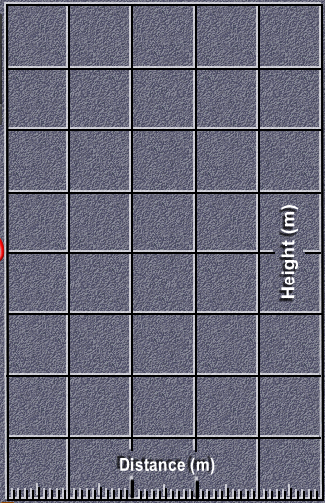VIRTUAL LABS
X
Motion and Momentum
How does horizontal motion affect vertical motion?
Anything that is thrown or shot through the
air is called a projectile. Because of Earth's
gravity and their own inertia, projectiles
follow a curved path.
When you throw a ball, the force from your hand gives the ball horizontal motion. When you let go of the ball, gravity begins to pull it down, giving it vertical motion. Vertical motion is perpendicular to Earth's surface. The ball has constant horizontal velocity, but increasing vertical velocity. The ball's horizontal and vertical motions are completely independent of each other.
In the Virtual Lab, you will use a launcher to give motion to a ball. You will use what you know about motion to calculate where the ball will land.
Objectives:
Procedure:
1. Click the Video button. Watch the animation.
2. On the activity screen, the tension indicator of the ball launcher is set at zero meters/second. The ball will have no horizontal velocity.
3. Click Launch to time the vertical drop of the ball in seconds. Click the Table button and record the data, in the Time column. Enter the velocity in the Table.
4. Click the Calculator button. Using the formula d = vt, enter the distance in the Table. Close the Table.
5. Drag the ball back to the launcher, reset it, and try the activity again, using a different launch height and tension.
6. Predict where the ball will land. Remember to calculate distance. Record your prediction in your Journal. Place the bell on the predicted landing spot.
7. Click the Launch button. Observe the path of the ball. Record your observations in your Journal.
8. Continue to predict in your Journal the distance the ball will go, using different launch heights and velocities. Enter each set of data in the Table.
9. Click Journal and use the data you collected to complete the Journal questions.
When you throw a ball, the force from your hand gives the ball horizontal motion. When you let go of the ball, gravity begins to pull it down, giving it vertical motion. Vertical motion is perpendicular to Earth's surface. The ball has constant horizontal velocity, but increasing vertical velocity. The ball's horizontal and vertical motions are completely independent of each other.
In the Virtual Lab, you will use a launcher to give motion to a ball. You will use what you know about motion to calculate where the ball will land.
Objectives:
- Explain the effect of gravity on horizontal velocity.
- Calculate distance given velocity and time.
- Explain that horizontal and vertical motion are independent of each other.
Procedure:
1. Click the Video button. Watch the animation.
2. On the activity screen, the tension indicator of the ball launcher is set at zero meters/second. The ball will have no horizontal velocity.
3. Click Launch to time the vertical drop of the ball in seconds. Click the Table button and record the data, in the Time column. Enter the velocity in the Table.
4. Click the Calculator button. Using the formula d = vt, enter the distance in the Table. Close the Table.
5. Drag the ball back to the launcher, reset it, and try the activity again, using a different launch height and tension.
6. Predict where the ball will land. Remember to calculate distance. Record your prediction in your Journal. Place the bell on the predicted landing spot.
7. Click the Launch button. Observe the path of the ball. Record your observations in your Journal.
8. Continue to predict in your Journal the distance the ball will go, using different launch heights and velocities. Enter each set of data in the Table.
9. Click Journal and use the data you collected to complete the Journal questions.







![]()



















![]()



















![]()



















![]()

































